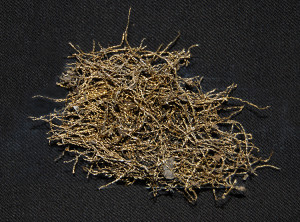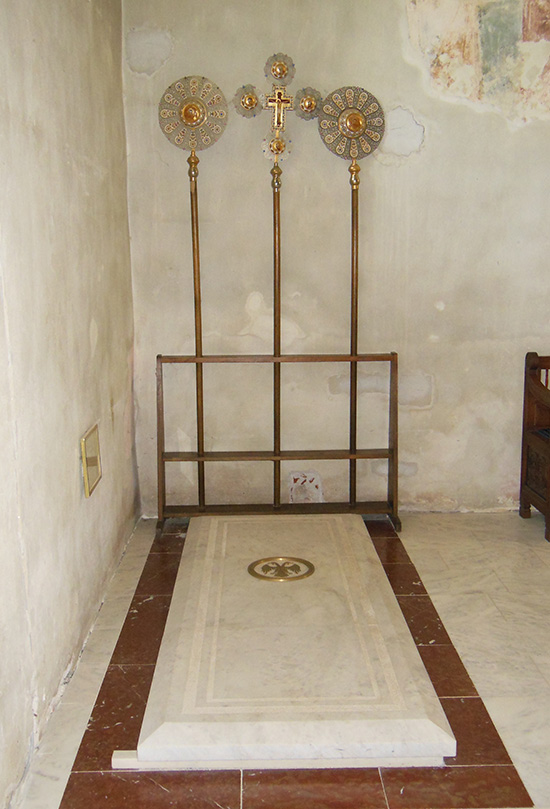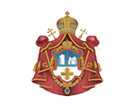-
A grave has been discovered next to the south wall of the west bay during the systematic archaeological excavation of the naos of the church of the monastery. According to the knowledge about the funeral traditions in the medieval Serbia, there surely was the grave of the founder.
After the removal of the stoned plates from the ground found in the west bay and laid in the 19th century, and the removal of the former ground of tile, from 1718-1739, has discovered the foundation of the earliest ground in mortar lime.
In the space of the south part of the west bay, between the porter zones of the south and west wall of the naos and of the porter wall binding the base of the south east pillar, below the dome, to the west wall, the below a tenuous layer of mortar mixed with lime and soot in the layer of beaten earth and concentration of mortar, lime, amorphous block of limestone, a funeral hole has been seen. In the earth with which has been recovered this space contains in the entire dig up layers numerous fragments of the paintings and of the oculus. On an inferior point has been noticed a serial of regularly disposed tiles, but only well preserved in the south part.In the north part has only been discovered tiles, which lets us supposed the grave has been profaned. After the removal of the tiles and blocks of limestone from the bottom of the funeral hole, were found parts of a skeleton and of the building. After a cautious and detailed cleaning, has been discovered a skeleton in an anatomical position. The bones of the deceased have not been moved during the previous digging.Next to the skeleton were only found textile fragments, probably silk, with traces of strings of gold and silver. The traces of wood and the nails of iron surely indicate that the deceased was laid in a wooden coffin in the grave, below it are two blocks of massive stone.

According to the discovered data on the grave and the defined stratification it is possible to consider with a high certainty the reconstitution of its aspect, the procedure of the funeral and to draw some conclusions about its profanation.
The rectangular grave is 2.20 meters long, 0.7 meters wide and 1.40m deep. The walls are made of carved blocks of stones irregularly disposed. A few rectangular bricks have been discovered along the south and east side of the grave, in alternate rows. The mode of construction of the grave indicates it has been quickly built with materials found in the monastery.The funeral hole has been digging in the southwest corner of the bay. Two carved blocks of stone have been put into the hole on which was laid the coffin with the remains of the deceased. After that, carved stones have covered the space around the grave, and bricks laid on alternate rows have filled the space between the vertical sides of the coffin and of the walls around. On the lid along the coffin have been regularly disposed as non-attached bricks by mortar, covered then by a layer of earth. A layer of amorphous blocks of limestone, with a roughly flat surface has been put above, hermetically closed by a weak quality material. The plate covering the coffin, of which there is no trace, probably lied on this limestone surface.
Those who profaned the grave first took the limestone layer from the west and the east, and then begun the digging up along the north side of the grave. This way has been discovered a part of the coffin, and the aim was to get to the head, the waist and the arms.
-
The opened question that remains is whether there was something else apart from the skeleton in the coffin, maybe a ring or a buckle of a belt. It is supposed that the grave has been profaned a little after the funeral, maybe in 1439 when the Turks destroyed Resava for the first time.
According to the results of the first archaeological excavations published of the church of the monastery of resava, published for the first time it’s possible to estimate that in the grave located next to the south wall of the west bay have been discovered the terrestrial relics of the founder – The Despot Stefan Lazarević.

Some data and facts left by Constantine the Philosopher, contemporary and biographer of the Despot leads to that conclusion. The burial place of the despot is mentioned in ulterior sources. So, the monks Damnjan and Pavle affirm in a letter written in 1597 to the Pope Clement that the Holy remains of Stefan are in Resava.
During his life, the despot Stefan Lazarević built the mausoleum dedicated to the Holy Trinity, in the monastery of Resava. Of this testify Constantine the Philosopher in his biography of the Despot Stefan Lazar Lazarević “ He built himself there a grave, where he soon was buried” and when he speaks, the transfer of the body of the despot “ […] they brought him to the grave […] he built himself in Resava […] to lay him at the place he ordered” and “because of the hurry, they arranged him quickly and laid him in the church in Resava on the right of the entrance to the temple.”
The space next to the south wall of the west bay was exclusively aimed, in medieval Serbia, to the funerals of the founder. In this place were buried all the founders of the Nemanjić dynasty, and also the parents of the despot Stefan, the Prince Lazar and the Princess Milica. This custom hasn’t known any alteration and no personalities being the founder has never been buried next to the south wall of the west bay.
The data left by Constantine the Philosopher about the death of the Despot, the transfer of his remains and his place of funeral are plainly confirmed by the result of archaeological excavations. The confirmation that the Despot Stefan, after his sudden death on July 19th 1427, has been transferred and buried in his foundation “[…] at the place he ordered”, is proved by the anthropological and D.N.A analysis. They corroborate the kinship between the father and the son, the Prince Lazar and the Despot Stefan Lazar Lazarević. So, 600 years later was solved the mystery of the place of the burial of the Despot Stefan Lazarević.
Graves in the Narthex – 18th and 15thcentury (Kalojan Rusota)
-
After the removal of the funeral marble plate and of the thin layer of sand, has been discovered a grave 1.4m long and 0.45m wide. In the layer of earth mixed with burnt soot were discovered the remains of skeletons of two men, who certainly have been buried later. On the basis of the fragments of tiles in the Austrian shape, with which where covered the walls of the grave, of eight small crosses of bronze found and pieces of a ceramic recipient, enables to locate that also corroborate the date of the grave, in the 18th century.
Two massive rectangular plates of stone of 0.2m large have been discovered in the bottom of the grave, with surfaces and the edges cautiously carved. Their discovery conditioned the dismantling of the former grave and the enlargement of the digging surface. Therefore, have been noticed the carved blocks of stone represent the lid plates of the latter grave, whose rectangular walls were cautiously built with tiles in mortar of limestone.
-
After the removal of the plates a wooden coffin was discovered in an exceptional condition with a well-preserved skeleton of a 60 to 65 years old man. The deceased has been buried on the back with the crossed hands on the level of the pelvis. There were no funeral objects in the grave.
In a historical anal has been conserved the note saying that Kalojan Rusota died on april 16th 1437 and he was buried at the Monastery of Resava, were his whole body rested. It is considered that in the narthex of the Monastery of Resava was discovered the place of the burial of Kalojan Rusota, custom-officer from Novo Brdo in Kosovo, who had an influence at the court of the Despot Stefan, but also at the court of his successor the despot Djurdje Branković.
